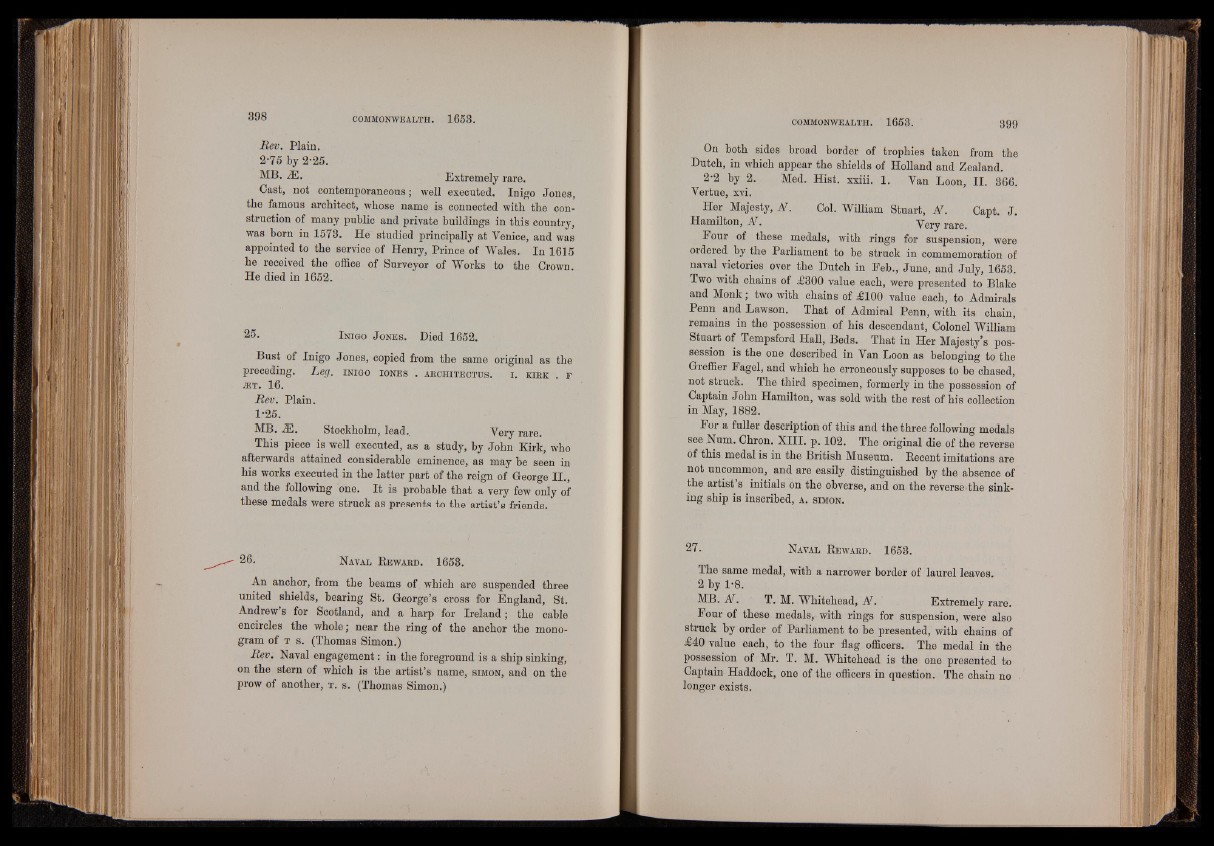
Rev. Plain.
2-75 by 2-25.
MB. 2E. Extremely rare.
Cast, not contemporaneous; well executed. Inigo Jones,
the famous architect, whose name is connected with the construction
of many public and private buildings in this country,
was born in 1573. He studied principally at Venice, and was
appointed to the service of Henry, Prince of Wales. In 1615
he received the office of Surveyor of Works to the Crown.
He died in 1652.
25- I n ig o J o n e s . Died 1652.
Bust of Inigo Jones, copied from the same original as the
preceding. Leg. in ig o io n e s . a r c h it e c t u s . i . k ik e . r
.®t . 16.
Rev. Plain.
1-25.
1MB. M . Stockholm, lead.. Very rare.
This piece is well executed, as a study, by John Kirk, who
afterwards attained considerable eminence, as may be seen in
his works executed in the latter part of the reign of George II.,
and the following one. It is probable that a very few only of
these medals were struck as presents to the artist’s friends.
26. N aval R ew a b d . 1653.
An anchor, from the heams of which are suspended three
united shields, bearing St. George’s cross for England, St.
Andrew’s for Scotland, and a harp for Ireland; the cable
encircles the whole; near the ring of the anchor the monogram
of t s. (Thomas Simon.)
Rev. Naval engagement: in the foreground is a ship sinking,
on the stern of which is the artist’s name, s im o n , and on the
prow of another, t . s . (Thomas Simon.)
On both sides broad border of trophies taken from the
Dutch, in which appear the shields of Holland and Zealand.
2-2 by 2. Med. Hist, xxiii. 1. Van Loon, II. 366.
Vertue, xvi.
Her Majesty, N . Col. WUliam Stuart, N . Capt. J.
Hamilton, N . y ery rare_
Four of these medals, with rings for suspension, were
ordered by the Parliament to be struck in commemoration of
naval victories over the Dutch in Feb., June, and July, 1653.
Two with chains of £300 value each, were presented to Blake
and Monk j two with chains of £100 value each, to Admirals
Penn and Lawson. That of Admiral Penn, with its chain,
remains in the possession of his descendant, Colonel William
Stuart of Tempsford Hall, Beds. That in Her Majesty’s possession
is the one described in Van Loon as belonging to the
Greffier Fagel, and which he erroneously supposes to be chased,
not struck. The third specimen, formerly in the possession of
Captain John Hamilton, was sold with the rest of his collection
in May, 1882.
For a fuller description of this and the three following medals
see Num. Chron. XIII. p. 102. The original die of the reverse
of this medal is in the British Museum. Recent imitations are
not uncommon, and are easily distinguished by the absence of
the artist s initials on the obverse, and on the reverse the sinking
ship is inscribed, a . s im o n .
27. N aval R ew a r d . 1653.
The same medal, with a narrower border of laurel leaves.
2 by 1-8.
MB. N . T. M. Whitehead, N . Extremely rare.
Four of these medals, with rings for suspension, were also
struck by order of Parliament to be presented, with chains of
£40 value each, to the four flag officers. The medal in the
possession of Mr. T. M. Whitehead is the one presented to
Captain Haddock, one of the officers in question. The chain no
longer exists.